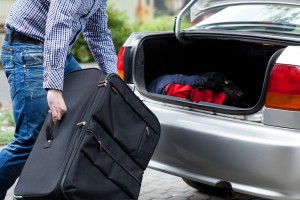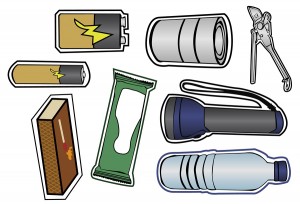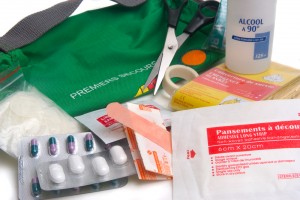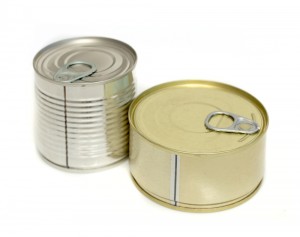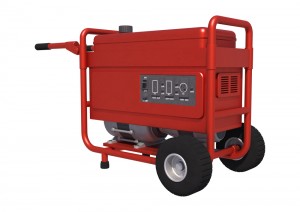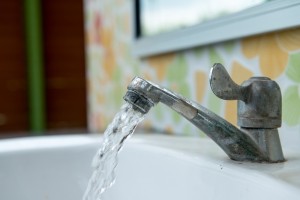Living in South Florida is fantastic—we love it, and that’s why we’ve chosen to live and work here for decades. But, of course, the beauty of our beloved state is balanced by the pervading threat of huricanes and tropical storms. Learning to properly prepare for a hurricane is an absolute must.
Hurricane and storm preparation is most effective when done year-round. Purchasing supplies and tools for surviving in a high category hurricane requires significant investment, so it’s best to space out your purchases over time.
Additionally, there are the processes of developing emergency, evacuation, prep, and contingency plans. These should be written out, memorized, and even rehearsed with your family. The last thing you want is to create an emergency plan when the eye of the storm is upon you!
But if the warnings are out and you’re short on time before the storm strikes, it’s useful to have a tangible list of items that require your immediate attention. Follow this guide to know how to prepare for a hurricane in the 24 hours before it arrives.
Decide Between Evacuating or Weathering out the Storm
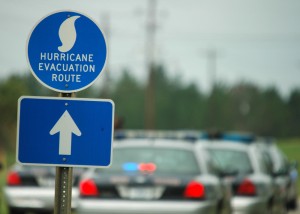
If you meet the criteria for evacuation, do it–trying to protect your property isn’t worth putting you and your family in harm’s way.
You have two choices when you know a hurricane is approaching, you can stay or you can leave.
There are lots of reasons why people choose to remain at home when aware of the dangers. Often, this involves financial considerations; many lack the money to travel to safe zones and pay for food and lodging out of town. There’s also the desire to protect one’s property, be it from the effects of the storm or from looters.
As legitimate as some of these considerations are, remember that your first and greatest priority is your personal safety and that of your family. Putting your life on the line for the sake of your home and belongings isn’t worth it if your actions result in injury or death.
Also, remaining in a high-risk area during a storm can lead to you needing emergency rescue services; in such a case, you’re now endangering the life of the rescuer in addition to yours and your family’s.
You should evacuate under these circumstances:
- You live in a tall building. The fast winds of a tropical storm or hurricane make tall, multi-floor buildings sway. If you’re in a high rise, it’s best to get out rather than place yourself in jeopardy.
- You live in an area prone to storm surge. Storm surge is a rise in water levels above that of the regular tides, and it’s directly caused by a storm. Storm surge was responsible for 1500 deaths during Hurricane Katrina. Research your property and area to determine the threat of waves and flooding.
- Your live in a mobile home. As nice as mobile homes are, they’re not the safest structure for emergency situations, especially tropical storms and hurricanes. The strong winds alone can blow your home over and the storm surge can drag it out to sea. Make plans to evacuate if you’re in a mobile home.
- You receive an evacuation order from the local authorities. If the government and appropriate agencies issue an evacuation order in your area, pack up and get moving. They know what’s coming and what will happen if you stay.
- You’re a Medically Dependent Consumer of Electricity (MDC). If your health condition requires the use of electrically-powered equipment (ventilators, oxygen concentrators, ventricular assistance devices) or appliances (for instance, a microwave for heating fluids), you should strongly consider the viability of evacuation. Should you decide to shelter in place, keep in mind that you become more vulnerable the longer power is out.
- Many local governments administer programs designed to keep track of and offer help to people in such situations. See the Broward County Vulnerable Population Registry for an example.
How to Plan an Evacuation
If you meet the criteria for evacuation, take every measure possible to make it happen. As mentioned above, no consideration is more important than your life and safety.
If money for a hotel out of town is an issue, try calling in favors. Find someone at whose place you can crash or who can lend you the funds for lodging. You surely have distant family or friends who are understanding and more than willing to help in such an urgent situation.
If you have no one to help you out, you can find a shelter and wade the storm out in a safe location green-lighted by the government.
Residents of Broward County can find local shelters here.
For the rest of Florida, check out this shelter index.
If you live anywhere else in the US, you can use the Red Cross’s Shelter Search.
What to Take if you Evacuate
When you leave to escape the a storm, you want to make sure not to forget any of these items:
- Food (non-perishables like canned food)
- Drinking water
- At least a week’s worth of clothes
- Laundry detergent in case you’re out longer than a week
- Container for gas in case stations on the road are low
- Important Documents (birth and marriage certificates, medical records, insurance policies)
- Items of High Personal Value (family photographs, family heirloom, etc.)
If you can, leave at a time when there’s not much traffic on the road, like between midnight and 4:00am.
Before you leave, be sure to your home is protected against the storm (and possible looters) as much as possible. More on that below.
If You Stay, Prepare Yourself
“By failing to prepare, you are preparing to fail.”
― Benjamin Franklin
Since we’ve already established when you should be evacuating, I’m going to assume that if you’re staying, it’s because you actually have a high probability of surviving without injury or ailment.
First, it’s time to stock up. Hopefully you’ve already assembled a viable emergency food and utility supply throughout the year. Waiting until the day before the storm guarantees long lines, scarcity, and probable unavailability of many of the things you’ll need.
Nevertheless, if you need to begin building your supply now, or if you just want to review necessary items to know whether you’re missing anything, here’s what to include:
Hurricane Tools and Utilities

Withdraw cash to use during a tropical storm or hurricane, since electronic pay methods may be out of order.
- Flashlights, glow sticks, candles
- Battery-operated radio
- Extra batteries
- Matches
- Plastic garbage bags
- Blankets
- Duct tape
- Clock/Watch
- Can Opener (essential if you want to eat!)
- Several sets of clean clothing
- Toiletries
- Keys to house and vehicles
- All your important documents (ID, passports, etc.)
- Pet supplies if you happen to have pets
Medical Supplies
Injury may occur during a storm and medical attention will be scare, so it’s critical you have first-aid supplies on-hand. Here’s what you need:
- Prescribed medication
- Bandages and adhesive tape
- Sunscreen
- Thermometer
- Tweezers
- Medicine apt for children
- Hygiene items for women
- Anti-septic Solution
- Medical tags if you suffer from a particular condition
And, naturally, there’s the matter of food. No hurricane supply is complete without adequate food and water.
- Drinking water: 1 gallon daily per person
- Enough canned food to last at least a week
- Snacks: dried fruits, cereal bars, chips, whatever lasts and helps lighten the situation
You’ll want coolers to store your victuals. Devote one to water and one to food. Also, it’s wise to invest in a camping-style range that you can hook up to a propane tank and use to cook in the event power and public gas are cut (which is most likely during a major storm).
Getting Water
Water is perhaps the single most important item you should stock up on. You need ample drinking water because your body can’t go more than a few days without it. And non-drinkable water for bathing, flushing the toilet, and similar activities will make the uncomfortable situation a bit more bearable.
If you find yourself short on water, there are ways to get it.
One method is to heat a large pot of undrinkable water and capture the vapor with a rag, towel, or garbage bag. The water captured is drinkable.
Similarly, you can build a solar still that captures water by means of a tarp. Learn more about doing that here.
Also, if you happen to have a water heater that stores water in a tank, you can use it to get up to 60 gallons of clean drinking water during a storm. Follow the instructions here (note: this technique doesn’t work with tankless water heaters).
Protecting Your Home
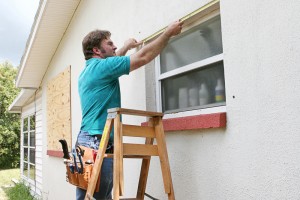
Board up your windows to prevent water and dangerous flying objects (as well as looters) from getting in.
Now it’s time to set up your home defense. Take the following steps to strengthen your home against a Tropical Storm.
- Trim the trees near your home to prevent weak/dead branches from falling onto your house
- Board up the windows or use shutters
- Lock your doors and put up drapes (this deters looters and criminals)
- Put away everything that can be blown around indoors, preferably into the garage
- Keep a radio with hurricane news switched on
- Put all your important documents in a water-proof container
Make sure to select a room that’s centrally located and preferably without windows as your place to wait out the storm.
Using a Generator
Buying a generator is a good idea. Depending on the severity of the storm, you may be without power for days. A generator can help you be more comfortable.
Purchase 5-gallon gas cans and fill them up so that you have enough to run your generator. Check to be sure it’s working prior to the storm so that you don’t have an unpleasant surprise when you really need to use it.
If you don’t have a generator and can’t acquire one in time, try a more affordable DC to AC converter for your car, which you can use to power appliances in your home.
Just don’t do it when the car is in the garage, since the fumes are poisonous. Like wise, keep the generator away from the windows to prevent carbon monoxide from entering your home.
Always remember to exercise maximum safety when storing gasoline. Use tightly sealed containers and keep the gasoline in a shed, garage, or other place apart from where you live.
Learn more about proper gasoline storage and handling here.
Considerations for Apartment Dwellers
Securing yourself and your living space is a bit different when your live in an apartment. Here are some things to take into account:
- With duct tape, tape the panes of glass (windows, sliding doors) and then put a barrier like blankets or furniture between the glass and the room.
- Don’t risk going outside in the hours or first few days following a storm. You don’t want to draw unwanted attention to yourself from possible criminals.
- Don’t light candles or use flames in general during the storm, as they can blow over and cause a fire.
Taking Care of Your Pets
When a storm arrives, you want to take every step necessary to care for your pets. They’re part of the family, after all.
Take these steps to give your beloved creatures the best chance of survival:
- If your plan involves evacuating, remember that emergency shelters normally don’t allow animals. This means you need to make arrangements for your pet with a veterinarian, pet motel, or family friend outside the evacuation area.
- Assemble the following items: pet food, drinkable water, waste pan/litter box, animal first aid kit, medications, eating tray, and all veterinary records. Take these with you if you evacuate with your animal, or keep them in a safe, water-proof place if you ride the storm out at home.
- In the event you stay at home, be sure to tie your pet up in a safe location during the storm. The last thing you want is for him to wander out to a dangerous area, something that could endanger your life as well.
Final Tips
Just a few last things to take note of before the storm hits:
- As soon as the storm hits, treat any water coming out of your faucets as contaminated, since water treatment plants may be damaged or closed. Purify by boiling and/or using chlorine bleach.
- If you don’t have enough water to flush your toilets, don’t flush (unless you want foul odors in your home!). Instead, line-up a garbage bag to the toilet to collect waste. Collect water in your bathtub before-hand for use in flushing and bathing.
- Place barricades against your entrance-ways to stop intruders. After the storm, one of the biggest threats you face is desperate people acting dangerously, as well as delinquents who take advantage of the situation.
Proper preparation is vital in the hours preceding a storm. It can mean the difference between life and death. Review these steps carefully and use other available resources from trusted community organizations in preparation for hurricanes and tropical storms.
For guidance setting up a hurricane plan for your family or business, check out Ready.Gov and use their templates (such as this Family Emergency Contact Sheet).
For help knowing what to do with your Air Conditioning Equipment when a hurricane strikes, have a look at the following videos from our sister company, Aloha AC Repair Fort Lauderdale:


